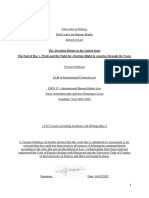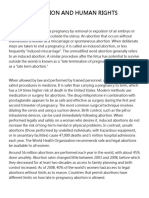0% found this document useful (0 votes)
134 views8 pagesAbortion
The document discusses abortion laws in the United States and Ohio. It provides background on the Roe v. Wade Supreme Court decision that legalized abortion nationally in 1973. It then describes recent laws passed in Ohio restricting abortion after a fetal heartbeat is detected, which conflict with Roe v. Wade. The document also discusses differing views on abortion and debates around balancing women's rights versus fetal rights.
Uploaded by
charles wambuiCopyright
© © All Rights Reserved
We take content rights seriously. If you suspect this is your content, claim it here.
Available Formats
Download as DOCX, PDF, TXT or read online on Scribd
0% found this document useful (0 votes)
134 views8 pagesAbortion
The document discusses abortion laws in the United States and Ohio. It provides background on the Roe v. Wade Supreme Court decision that legalized abortion nationally in 1973. It then describes recent laws passed in Ohio restricting abortion after a fetal heartbeat is detected, which conflict with Roe v. Wade. The document also discusses differing views on abortion and debates around balancing women's rights versus fetal rights.
Uploaded by
charles wambuiCopyright
© © All Rights Reserved
We take content rights seriously. If you suspect this is your content, claim it here.
Available Formats
Download as DOCX, PDF, TXT or read online on Scribd
/ 8




























































































